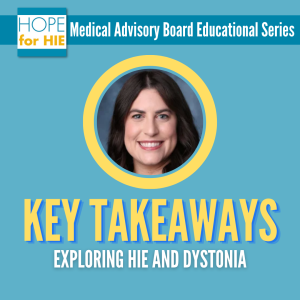
At Hope for HIE, we hold the providers who showcase their commitment and passion for research and improved clinical care practices for those impacted by HIE’s various outcomes near and dear to our hearts.
So when Dr. Laura Gilbert, a pediatric neurologist at Lurie’s Children’s Hospital, teamed with us during Cerebral Palsy Awareness Month to shed light on a prevalent outcome of cerebral palsy, childhood dystonia, we were grateful to witness her dedication to equipping our HIE community members with the resources and knowledge they need to navigate their journey with this complex condition.
Missed the live stream Q&A? No worries. We took notes, and like any good partner, we are willing to share! Read our key takeaways below.

While often linked and sometimes overlapping, cerebral palsy and dystonia are distinct conditions with unique characteristics. Cerebral palsy is a broad term encompassing a range of movement disorders caused by damage to the developing brain, while dystonia specifically refers to involuntary muscle contractions that result in repetitive movements or abnormal postures. While dystonia can be a component of cerebral palsy, not all children with cerebral palsy experience dystonia, and vice versa.
In fact, it’s estimated that around 40% to 60% of kids with CP experience some form or severity of dystonia, and it is typically more prevalent in certain subtypes of CP, like dyskinetic and mixed.
This goes to show that knowing the distinctions between the two can go a long way toward receiving an accurate diagnosis and forming a tailored treatment approach, but we’ll explain more about that soon.
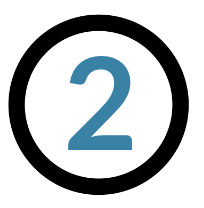
Doctors are still learning how, exactly, dystonia occurs, but despite its variability among those who have it, they do know for sure that it is a network disorder that occurs when one or more complex circuits in the brain are impacted. Cerebral palsy is the most common cause of childhood dystonia, and with around 40% of children with HIE developing some form and severity of CP, it makes sense to know what dystonia is, its various signs and symptoms, and its potential triggers.
Simply put, dystonia is involuntary muscle contracting that leads to tightening, stiffening, twisting, or abnormal posturing of the legs, arms, head, or trunk. Dr. Gilbert likens it to a miscommunication in the brain that causes extra muscles to join in when you’re trying to move a specific part of your body.
Triggers change and look different for everyone, but they commonly include:
Like HIE, dystonia has a range of severity and functionality. Some may have mild dystonia, where their level of function is not impaired enough to impact their daily lives aside from some struggles with fine motor skills or tripping when walking; others may demonstrate severe generalized dystonia that affects a range of motion and movement in their arms, legs, trunk, neck, or face. The impacted body parts are often associated with the location of their brain injury.
Sleep adds another variable: for some, dystonia may temporarily improve or even resolve during sleep. In a phenomenon called “sleep-related dystonia alleviation,” muscle activity generally decreases, which can lead to a reduction in dystonic movements or postures. Again, this is not a universal experience; how dystonia affects sleep can vary depending on its severity, the specific muscles involved, and individual differences in sleep patterns.
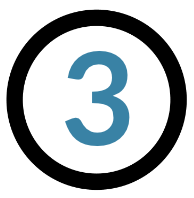
To demonstrate this, in a research setting with trained assessors, it was recognized that up to 70% of individuals with spastic CP have dystonia. Yet, in Dr. Bhooma Aravamuthan’s lab at the Washington University School of Medicine in St. Louis, they discovered that only 13% of those with known dystonia were diagnosed as having it in a clinical setting, making for quite the diagnostic gap.
Many providers, including pediatric neurologists, physiatrists (PM&R), physical or occupational therapists, or even neurosurgical or orthopedic teams, can diagnose dystonia. Who provides this diagnosis depends on your child’s healthcare team and the timing of their dystonia onset: while these movements can occur in early infancy, other children have a delayed onset.
While there are assessment and diagnostic tools in place to provide this diagnosis, they have their limitations: they can take a long time to perform, for instance, and a child’s dystonic posturing does not always happen during a clinical visit. (Dr. Gilbert’s advice? Take videos to show to your child’s clinician!) Another downfall is the difficulty level of differentiating dystonia from other tone types, like spasticity.
That’s why many researchers, such as Dr. Gilbert herself, are trying to develop novel assessments to close that diagnostic gap. She is working on combining clinical definitions of dystonia with caregiver descriptions, perceptions, and daily experiences. The goal is to create a comprehensive tool for caregivers that has been developed by caregivers themselves.
But the research doesn’t end there. Dr. Bhooma’s lab is working on quantitative motion analysis, a process in which advanced technology carefully measures and analyzes dystonic movement patterns in children to identify its various causes and develop better diagnosis and treatment methods in the process.
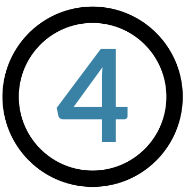
Like all care, treatment should be tailored to your child’s severity of dystonia, level of impaired function, and pain. So, while these categories serve as a great starting point, having these conversations with your child’s healthcare team is important to create the best-individualized approach.
After discussing with your child’s provider whether dystonia is causing issues with movement, pain, or sleep, you may want to explore medication options. It’s important to understand that while medications can be helpful, they’re not perfect, as they may not completely control dystonia symptoms and can sometimes bring unwanted side effects that could impact daily functioning.
According to the American Academy of CP and Developmental Medicine care pathway, oral baclofen is often recommended as a first-line medication, followed by trihexyphenidyl if needed. Interestingly, medications and their side effects can sometimes be turned to your advantage. For example, if a child with dystonia struggles with sleep, their doctor might suggest trying a medication known to cause drowsiness as a side effect to improve sleep quality.
Botox injections into the specific impacted muscle are another route to consider. These injections block a certain neurotransmitter that signals muscles to contract, effectively weakening those targeted muscles and lessening the involuntary muscle activity contributing to dystonia symptoms.
Surgical options are available for children with severe dystonia or spasticity who have not responded adequately to other treatments or medications, as outlined above. Like any surgical procedure, these options do have associated risks and require careful evaluation by a medical team experienced in their use.
- Deep brain stimulation (DBS) is a procedure that is gaining more interest in the field and requires more studies to determine who exactly qualifies for its treatment. It involves implanting electrodes into specific, deep areas of the brain that deliver electrical impulses to tell that part of the brain to lessen dystonia symptoms.
- Lesional surgical options, like Thalomotomy and Pallidotomy, involve selectively scarring specific areas of the brain or nerves to reduce abnormal muscle activity.
- Selective Dorsal Rhizotomy (SDR) is typically considered a surgical option for individuals with cerebral palsy, particularly those with spasticity that affects the lower limbs and interferes with mobility and daily function. It is important to note that dystonia is a potential, relative contraindication of this surgery, meaning that dystonic symptoms can either be unmasked or marked as more severe after having had it performed.
Rehabilitative routes for dystonia treatment focus on enhancing comfort and stability through tailored seating and equipment solutions, as well as identifying and managing your child’s triggers once they are recognized and well-understood.
Goal-directed therapies can also play a helpful role, especially since heightened emotions such as excitement, anxiety, or worry can trigger dystonic episodes. To address this, working with psychologists can be beneficial. They can help your child learn coping mechanisms and techniques through cognitive behavioral therapy, which focuses on identifying and changing negative thought patterns and behaviors and learning practical skills to manage stress, anxiety, and other emotional challenges.
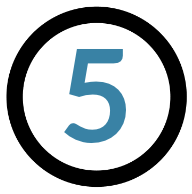
Status dystonicus, also known as dystonic storming, is a rare but serious complication of dystonia characterized by a quick and severe worsening of dystonic symptoms. It can occur in all age groups but is most commonly observed in children ages 5 to 16. During a dystonic storm, children can experience intense and prolonged muscle contractions or spasms in various muscle groups, leading to considerable discomfort, pain, and challenges with movement.
While there is more to learn about what exactly causes dystonic storming, triggers may include irritability, dehydration, constipation, stress, infections, or alterations in medications. A dystonic storm episode may last anywhere from a few hours to several days and, in some instances, weeks. This doesn’t just impact tone; it impacts body temperature and can lead to exhaustion and dehydration, which is why providers will often want to monitor electrolyte levels and other organ functioning, like the kidneys, to ensure they have not been severely affected.
Dr. Gilbert stresses the importance of recognizing the signs of dystonic storms as early as possible and seeking immediate intervention and hospitalization, where the healthcare team can offer close monitoring and supportive care. Treatment varies for every individual based on the severity of the storming but often involves the administration of medications such as benzodiazepines, muscle relaxants, intravenous fluids, or, in some more severe cases, sedation to alleviate symptoms.

And that, as Dr. Gilbert states, makes this an exciting time in the field of neurology. While there’s still much to learn, it’s exciting to see the following projects on the horizon, offering hope for improved treatments:
| ➡️ Physician-scientists are investigating the genetics of dystonia and cerebral palsy to identify which treatments, like deep brain stimulation (DBS), might be most effective for different individuals. They’re also exploring biomarkers that could help personalize treatments.
➡️ Researchers are also exploring the safety and efficacy of a non-invasive treatment called focused ultrasound pallidotomy for dystonia. It uses targeted ultrasound waves to make small lesions in the globus pallidus, a brain area that controls movement. This disrupts abnormal brain activity, easing dystonia symptoms. The appeal? It doesn’t require general anesthesia and seems promising for managing dystonia with fewer risks. ➡️ Plus, researchers are looking into combined rhizotomies for people with spasticity and dystonia, which would provide better relief and function for both conditions. |
Now, you may be wondering: given that HIE-acquired dystonia does not respond to the same medications as other causes of dystonia, is there research that focuses on management for our HIE children?
In short, yes! While much of the research has historically concentrated on adult-onset dystonia or genetically isolated dystonias, there’s a growing emphasis on studying dystonia in individuals with cerebral palsy and HIE because they have such distinct needs. CP is a diverse disorder, making it difficult to understand why treatments vary in effectiveness among individuals, but one proposed solution is conducting trials that compare medication efficacy within specific subgroups, such as people with CP, dystonia, and HIE, and evaluating outcomes like pain, function, and side effects unique to these shared underlying risk factors.
So, while research has focused on studying underlying genetic variations of dystonia, it’s not for naught. Doing so can ideally lead to individualized treatments, marking these advancements as a true “genetic revolution,” as Dr. Gilbert calls it.
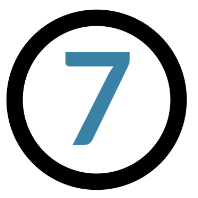
To watch the full live stream, visit our YouTube channel below, or click on our Key Takeaways for an at-a-glance view of this session!
Connect with families, read inspiring stories, and get helpful resources delivered right to your inbox.